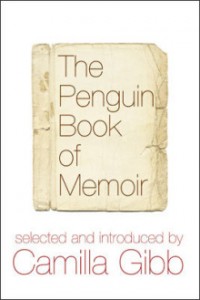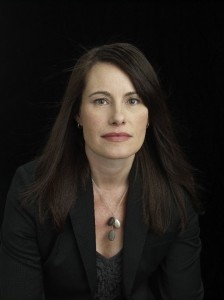Interview by Allyson Latta
Photo by George Whiteside
The Penguin Book of Memoir, published in April 2011, is a stirring and varied collection of stories by noted Canadian authors including Wayson Choy, Wayne Johnston, Ian Brown, Michael Ondaatje and Thomas King. “[A]n individual life is virtually never set apart;” writes anthology editor Camilla Gibb, “it unfolds in the context of family and community and is shaped by … social and political forces.” The Globe and Mail says, “Shunning windy accounts of the great and the good, or whinging chronicles of abuse, Gibb has chosen a middle ground: pieces that are beautifully crafted and capture a moment that shifts the balance in the midst of a life.”
AL: Camilla, what inspired The Penguin Book of Memoir?
CB: An invitation from Penguin, which gave me the opportunity to immerse myself in a genre of writing I hadn’t really explored in any depth before.
AL: How did the collection evolve, and what challenges, if any, did you encounter?
CB: I read Canadian memoirs over a period of about three years and certain texts stood out as essential. These would form the core, I knew, but I worried they would form a rather predictable core, being texts with which many readers are familiar. I asked myself what and who were not being represented and extended my reach. But I wouldn’t make selections simply because they represented a certain region or experience—above all, the writing had to be stellar.
As I say in my preface, I did not intend to have a collection of memoirs by writers—I cast the net wide—looking at political memoir, sports memoir and memoir by other notable Canadians, but in many cases the writing simply fell short. Memoir by public figures, furthermore, often has the help of a ghost writer or very involved editor (a fact that is usually obscured) so wherever this might have been an issue, I had to set the memoir aside. Authorship and voice were critical to my decision-making.
AL: Was it difficult to choose an excerpt from books whose structures are meant to tell a fuller story? How did you go about this?
CB: It was very difficult. There were many beautifully written memoirs which, because I couldn’t easily excerpt from, are not included in this collection. I needed pieces that had a degree of self-containment; that could be understood without further comment or context.
But I offer context for these pieces in terms of their placement in the collection. The order is one that has been carefully considered. There is an overall story, crafted by me, but inspired by the thematic echoes between the selections. There are Canadian memoirs that have challenged the conventional approach to memoir—stylistically or structurally—which are not included here, because they were too difficult to integrate into the overall story I was attempting to craft. I didn’t want this collection to be a “reader”—a comprehensive sampling of Canadian memoir—but a whole work with its own consistency, rhythm and integrity.
AL: What was it about the excerpt from Ian Brown’s The Boy in the Moon—the heartbreaking but inspiring story of life with his severely handicapped son—that you felt it would best finish off the anthology?
CB: As you move through the collection, the focus of the pieces becomes more and more intimate and domestically rooted. Brown’s piece is the most interior of all the pieces in the collection, and a fitting end to a book which is ultimately about the examination of the self and by extension, humankind.
AL: Did you consider including more short memoirs rather than excerpts?
CB: Yes, certainly. Many short memoirs, though, were not quite as short as they needed to be for purposes of this collection. Short pieces of memoir also have the unfair advantage of telling the whole story, where selections drawn from larger works do not, and I needed to have balance between the pieces in this regard.
 AL: What gives a memoir, short or long, staying power? What do you, personally, want to come away with after reading one?
AL: What gives a memoir, short or long, staying power? What do you, personally, want to come away with after reading one?
CB: The staying power is entirely to do with emotional resonance. I want to feel moved, and to feel better for having had the encounter.
AL: Memoir and family history are intertwined, as several of the stories in The Penguin Book of Memoir illustrate. Do you have a strong interest in your own family history?
CB: I have much more interest in the family histories of others. It’s the anthropologist in me.
AL: Does your social anthropology background give you a particular perspective on memoir, or lead you to look for memoirs that have broader social/political/cultural context?
CB: My background always leads me to ask how a life is shaped by the social and political forces that surround it. What I found fascinating in terms of this collection was what a Canadian story it told—people from such varied backgrounds having to reconcile a past set at geographic remove with a present set in a less imposing place. One fascinating example, particularly in light of recent political events, is the excerpt from Ignatieff’s Russian Album. Many Canadians have the luxury of being able to choose the principle narrative of their life—is it their family’s history in their country of origin, or is it the new life they have built here? Those choices can have political implications in themselves.
AL: In what way do you believe Canadian memoir has changed since the time of, say, Susanna Moodie and her Roughing It in the Bush? What about in the ten years since the publication of The Vintage Book of Canadian Memoirs, edited by George Fetherling?
CB: A lot of early Canadian memoir had an instructive purpose—introducing this strange new land to potential settlers, a how-to (or more often how-not-to guide) to survival. We have seen a move away from the themes Atwood identified in her book of the same name, a shift that is mirrored in both fiction and memoir. There has not been a massive shift in Canadian memoir in the past ten years, but there has been a proliferation as the genre gained (then lost) some respectability.
AL: That said, do you feel there are identifiable differences in style or sensibility between modern-day Canadian and American memoirs?
CB: Our audiences don’t seem to have quite the same appetite for scandal and sensationalism. We live in a smaller country, with few degrees of separation. We don’t seem as prepared to sell our stories at all cost, but then, we don’t see the same kind of financial rewards.
AL: You’ve said, “Fiction often has the advantage of reading truer than nonfiction, ironically.” Can you elaborate?
CB: I can tell you a story that you’ll never believe, one full of unbelievable coincidences, a story that is entirely true. Or I can edit out the unbelievable parts, rewrite that story as fiction, and give you a story that entirely makes sense.
AL: And what, then, is the pull of memoir—despite readers knowing that memory—and sometimes memoir, as evidence by some unfortunate recent cases of misrepresentation—can be unreliable?
CB: We continue to look for honest accounts of emotional experiences, ones that will tell us we are not alone in feeling what we do in the world.
AL: Moira Farr, one of the authors in your collection, writes that poking around “in the wreckage” left by her lover’s suicide is something that she “must do,” despite her fear of what she may find. What do you believe drives some to find the courage to share their stories?
CB: It’s a compulsion.
AL: There’s the compulsion to poke around, and then there’s the compulsion to share. Would you say it takes more courage to put one’s work out there as memoir, or can writing fiction, too, be a courageous act?
CB: Writing memoir probably involves more risks, but writing fiction, particularly tackling the complexities of our existence—our capacity for cruelty, for instance—can be just as courageous. When I say “compulsion,” I mean that to speak and be heard are necessary for one’s survival.
AL: To fix a memory to paper, you write, “. . . is to say: I exist.” Is this a particularly literary perspective, do you think?
CB: Writing things down is a privilege and a luxury that not everyone has the means to employ. Telling stories, however, is something we all do, and without them we would exist in meaningless isolation.
AL: Is writing fiction your way of saying: I exist?
CB: I suppose so, but that’s not the way I speak of my writing. My writing is me, it’s what I think and feel, it’s how I communicate and engage in the world, it’s how I make sense of things.
AL: And what are you working on now?
CB: A memoir . . .
AL: (Well, readers, I asked, but Camilla wasn’t willing to hint at the theme of her memoir. We’ll have to wait to find out.)
CAMILLA GIBB is the author of four novels—Mouthing the Words, The Petty Details of So-and-so’s Life, Sweetness in the Belly and The Beauty of Humanity Movement. She was the winner of the Trillium Book Award in 2006, a Scotiabank Giller Prize shortlist nominee in 2005, winner of the City of Toronto Book Award in 2000 and the recipient of the CBC Canadian Literary Award for short fiction in 2001. Her books have been published in 18 countries and translated into 14 languages, and the Orange Prize jury named her one of 21 readers to watch in the new century. Camilla is currently an adjunct faculty member of the graduate creative writing program at University of Guelph.

I finished reading The Penguin Book of Memoir this afternoon. I was privileged to see Camilla Gibb speak at an author reading at Wyndance Golf Club a few weeks ago. The following quote in the introduction in her book reminds me of why those of us who write memoir persist.
“Lives laid bare offer us all an opportunity for introspection and the reassurance that we, in all of our flawed glory, are not alone.”
I recently read Gibb’s book Sweentess in the Belly. The storyline and concepts she deals with have stayed with me. I look forward to seeing her again as the guest speaker at the Writers Community of Durham Region breakfast in early June.